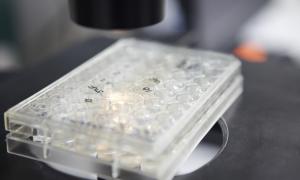New target to destroy the HIV reservoir

Researchers at IrsiCaixa and the University of Miami state at the PNAS journal that HIV uses macrophages as a reservoir and demonstrate for the first time that these cells contribute to the viral rebound if treatment is discontinued.
When an HIV positive person interrupts antiretroviral treatment, viral production starts again in most cases and will oblige the individual to restart antiretroviral treatment within weeks. This viral recrudescence exists because some virus hide in latent cells, called HIV reservoir. Until now, scientists believed that this reservoir contributing to viral rebound was mainly present in CD4 T cells, the main HIV target. Now scientists from the University of Miami and the IrsiCaixa AIDS Research Institute, a center promoted by the "la Caixa" Foundation and the Department of Health of the Generalitat de Catalunya, have described a new cell type from the immune system that is contributing to the viral rebound: the macrophages. Although the viral reservoir has been studied in macrophages before, it is the first time that scientists demonstrate its importance on viral recrudescence and these findings will have a huge impact on the design of new HIV eradication strategies.
Macrophages are cells of the immune system that are infected and can store virus even though they are not the main target for the HIV. The study published in the PNAS journal describes viral particles with preference for infecting macrophages and demonstrates that these virus appear in the blood when there is viral rebound. "This finding is of great relevance for those who study new HIV eradication strategies. Until now, it was unclear what parts of the dormant viral reservoir contribute to this viral rebound if antiviral treatment was discontinued" says Christian Brander, ICREA researcher at IrsiCaixa.
"So far, the study of the viral reservoir has focused mainly on T cells, because they are the main target for the HIV," says Javier Martínez-Picado, ICREA researcher at IrsiCaixa. “We wanted to study the reservoir in macrophages, cells of the immune system localized in the tissues. We knew that they are not the favourite target cells for HIV but they can be infected and we thought that their role could be important." Studying the HIV reservoir in macrophages is challenging because they reside in tissues that are not easily accessible in living subjects, such as the central nervous system.
To carry out this project, researchers collected a single plasma sample from six individuals on virus suppressive therapy who underwent antirretroviral treatment interruption. In all of them the virus had reappeared, so they had the virus detectable again in their blood. "We wanted to know if the viruses that appear after antiretroviral interruption were coming only from T cells or also from macrophages," says Brander.
Design of new cure strategies
From the plasma samples, scientists generated HIV clones with different envelope proteins and studied their ability to infect macrophages or T cells. The results show that depending on the type of envelope proteins on the outer viral membrane, some viruses will preferentially infect macrophages instead of other cell types.
Scientists have also been able to demonstrate that some of the macrophage tropic viruses were established before the therapy interruption and, therefore, came originally from reservoirs located in the macrophages. "When the virus comes out from the infected cell, fuses with the membrane to create the viral envelope. Studying the envelope we can know where these viruses come from and this is how we have been able to demonstrate that macrophages are cellular reservoirs and are capable of producing competent viruses when the therapy is interrupted" says Brander.
This study emphasizes the importance to keep in mind the macrophage reservoir to design new strategies aiming to eliminate HIV. This reservoir has to be eliminated in order to avoid viral recrudescence. "This new study makes the fight against HIV a little bit more challenging, but understanding how HIV works will help us to design new and better strategies for HIV eradication," concludes Martínez-Picado.